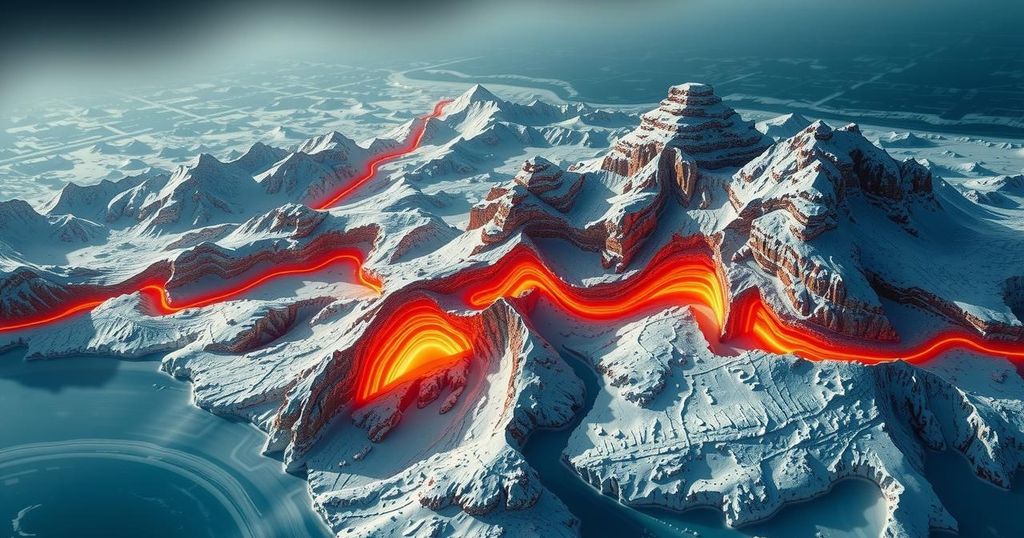The Impact of Climate Change on Earthquake Activity in Colorado’s Sangre De Cristo Mountains

Recent research from Colorado State University indicates that melting glaciers in the Sangre De Cristo Mountains may have increased earthquake frequency by relieving stress on underlying fault systems. This connection between climate change and seismic activity suggests that other glaciated regions could face heightened earthquake risks due to global warming, necessitating continued scientific investigation.
The Sangre De Cristo Mountains in southern Colorado, which rise sharply from the San Luis Valley, are influenced by an underlying fault system that has shaped the region over millions of years. Recent research suggests that the melting of glaciers thousands of years ago may have increased seismic activity in this area by alleviating pressure on the fault lines. This correlation between climate, specifically global warming, and geological activity may provide insights into increased earthquake threats in current and future glaciated regions.
The study, which has been published in the journal Geology, outlines how higher temperatures could activate fault systems in areas with receding glaciers. As stated by Sean Gallen, a co-author and geologist at Colorado State University, “Areas where glaciers are retreating, or changes in the hydrologic cycle are happening over active faults, might experience elevated earthquake activity.” This insight raises concern for other regions around the world where glaciers are melting.
The geological events that shaped the Sangre De Cristo Mountains began approximately 25 to 28 million years ago when the Rio Grande Rift formed. Following an extensive glacial period culminating around 20,000 years ago, the resulting ice cover would have exerted pressure on the Earth’s crust, stabilizing the region. As glaciers began to melt, this weight was lifted, potentially triggering increased seismic activity due to the release of previously contained stress.
To investigate this hypothesis, the researchers utilized sophisticated computer models alongside high-resolution lidar and satellite imagery to analyze geological formations such as moraines and fault scarps. These tools allowed them to reconstruct historical seismic events, revealing that the melting ice led to a fivefold increase in earthquake frequency. Eric Leonard, a geologist from Colorado College, concurs with the findings, noting that even smaller glaciers can significantly impact seismic activity. However, he points out uncertainties regarding the ages of the fault surfaces that may affect earthquake chronology.
While the study presents compelling evidence of the climate-earthquake link in the Sangre De Cristo region, its implications extend internationally. Notably, major ice masses in tectonically unstable regions—like the Himalayas, Andes, and Alaska—are at risk. As Eric Leonard articulated, “Will this significantly add to hazards? I do not know, but it certainly has potential. “The increasing global temperatures and subsequent melting of glaciers necessitate further research to assess the future earthquake risks amid these changes.
Climate change and seismic activity have historically been perceived as disconnected phenomena. However, recent research challenges this notion by establishing a potential link between the two. The concept of isostatic rebound, whereby the Earth’s crust adjusts to changes in surface load, provides a critical framework for understanding how melting glaciers can influence tectonic stress. By examining the correlation between glacier mass loss and increased earthquake frequency in the Sangre De Cristo Mountains, researchers can glean insights applicable to other glaciated regions experiencing similar climatic changes.
In conclusion, the study highlights a potential connection between climate change and increased seismic activity in regions with active faults. The melting of glaciers not only relieves pressure on fault lines but may also trigger elevated earthquake frequency. As global temperatures rise, it is essential to monitor active fault regions worldwide, particularly those with substantial ice masses, to mitigate the risks associated with these geological phenomena. Further research is warranted to deepen our understanding of these environmental and geological interactions.
Original Source: www.scientificamerican.com






